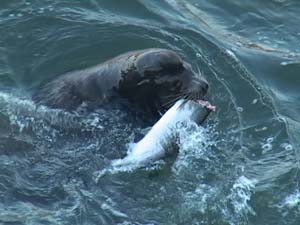forum
library
tutorial
contact

NOAA Fisheries Gives OK to Remove
Sea Lions That Prey on Salmon
by Laura Berg
NW Fishletter, September 6, 2016
|
the film forum library tutorial contact |

|
NOAA Fisheries Gives OK to Remove
by Laura Berg
|
 NOAA Fisheries has authorized the states of Oregon, Washington and Idaho to continue removing predatory California sea lions for another five years.
NOAA Fisheries has authorized the states of Oregon, Washington and Idaho to continue removing predatory California sea lions for another five years.
Sea lions congregating near Bonneville Dam feasted on nearly 10,000 adult spring Chinook last year. Their 2016 take was more than 3 percent of the adult fish returning to the Columbia River.
Some 25 to 35 percent of the fish consumed are listed under the Endangered Species Act, according to the federal fish agency.
The authorization, which allows the lethal removal of California sea lions identified as preying on steelhead and salmon, extends through June 30, 2021.
"It is one of many actions underway across the Columbia basin to address impacts on imperiled salmon and steelhead, including impacts from hydroelectric dams, hatcheries, harvest, habitat degradation and other predators," a statement by NOAA Fisheries said.
The states may euthanize the animals if no permanent facility, such as a zoo or aquarium, will take them. Lethal removal, however, is a last resort after other actions to deter individual sea lions are attempted, NOAA Fisheries said.
Since sea lion removal began in 2008, the states have removed 166 animals. This year 59 California sea lions were euthanized or transferred--the most in a single year to date.
The sea lion population has risen steadily since 2010, with the largest number ever, 120, counted this year.
For the past seven years, NOAA researchers have tagged spring Chinook and followed their migration from the estuary upriver to Bonneville Dam.
The study said that after accounting for harvest, annual spring Chinook survival to Bonneville has ranged from 55 to 90 percent. Or put another way, 10 to 45 percent of the tagged Chinook did not make it that far.
"Pinnipeds [sea lions] are probably the primary cause of this mortality, but there are possible other causes," said Michelle Wargo-Rub, the lead NOAA researcher. She reported results of the current year's work at a July 12 meeting of the Northwest Power and Conservation Council.
Sea lions that eat salmon on the Columbia River are mostly adult males from Northern California wintering in the Northwest before returning to that state's coastal waters in late spring.
California and Steller sea lions have traveled the Pacific Coast for centuries, but were not seen entering the Columbia River in significant numbers until the 1980s, a Washington Department of Fish and Wildlife website says.
This was after a decade of protecting Harbor seals and Steller sea lions under the Marine Mammal Protection Act of 1972.
Today the California sea lion population on the U.S. West Coast totals about 300,000 animals.
learn more on topics covered in the film
see the video
read the script
learn the songs
discussion forum
